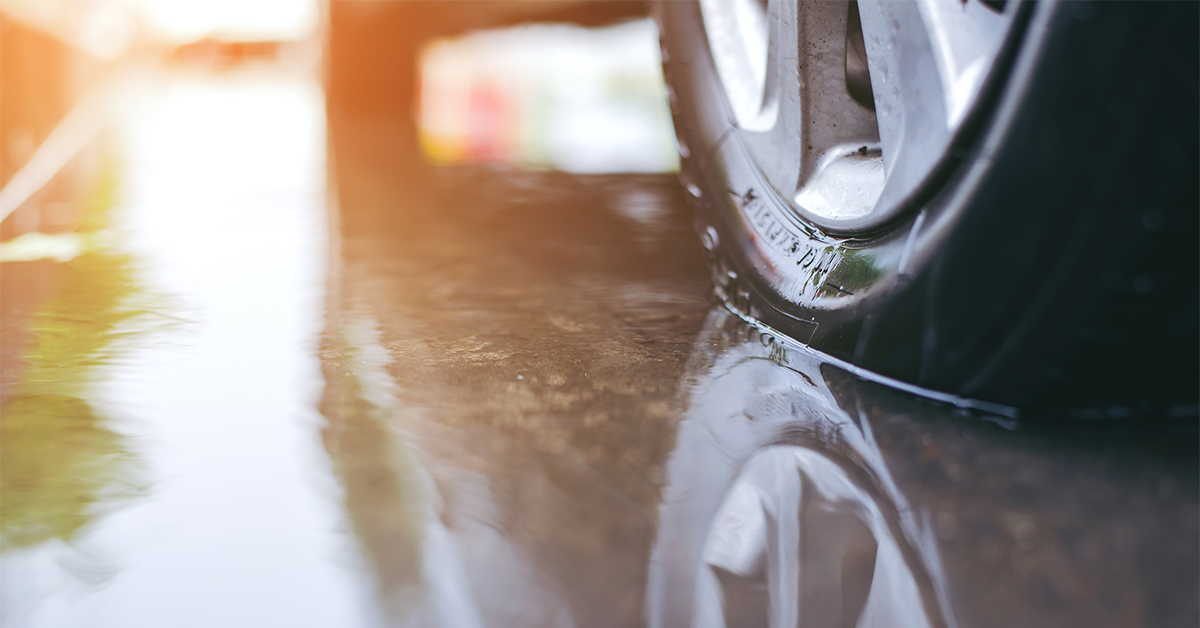Unbeknownst to the average driver, tyres are doing a remarkable amount of work during every trip. Not only are they dealing with rough surfaces, potholes, curbs and continual braking and accelerating, they’re also dealing with the dispersal of water in order to maintain grip.
During heavy downpours, a tyre in good condition is clearing a bucket of water every seven seconds. It sounds like a lot (and it is), but if a tyre can’t perform at this level, your car is in danger of aquaplaning.
What is aquaplaning?
Aquaplaning occurs when one or more tyres cannot adequately disperse water. When this happens, a layer of water builds up between the rubber and the road, essentially lifting the wheels off the road’s surface. This severely reduces friction and, if it occurs on all four tyres, the driver will be left with no control over the direction or speed of their car.
How do I know if I’m aquaplaning?
Aquaplaning can occur at any moment on a wet road. When it does, you’ll notice one or all of the following:
- Due to the loss of friction (resistance), the tyres will spin faster, increasing revs and engine noise.
- With no friction, the steering will become light.
- With no traction, the back wheels may begin drifting from side to side, something known as fishtailing.
What should I do when aquaplaning?
Aquaplaning can be a frightening experience. On a rainy night, the faster we travel the more water our tyres have to disperse every second. This means that there’s a higher chance of aquaplaning occurring on freeways and highways – not the place we want to lose control of our car.
If this happens to you, here’s what you should do:
- Don’t panic – easy enough to say, not so easy to do. When you suddenly and inexplicably lose control of your car, it’s very hard to remain calm, but doing so will give you the best opportunity to do the following:
- Don’t slam on the brakes.
- Ease off the accelerator.
- Don’t jerk the steering wheel; gently turn it to follow the slide of the car.
- If it’s on, switch off cruise control, if fact you shouldn’t really be driving in the wet with the cruise control on anyway.
- Gently pump the brakes until you feel the tyres regain traction.
How to minimise your chance of aquaplaning
It’s not totally unavoidable, but there are several factors within our control that can increase the chance of aquaplaning. Let’s take a look at them.
- Driving fast. As we’ve already mentioned, a car travelling at a high speed needs to disperse more water at any given moment than a car travelling at a lower speed. When it’s pouring down, ease off on the accelerator. This may mean going at five, 10 or 20 k’s below the speed limit. It may mean pulling off to the side and waiting for the deluge to ease.
- No Cruise Control. Switch off the cruise control in during heavy wet weather. When driving on hilly roads, the cruise control will accelerate to maintain the preset speed, something you don’t to happen during heavy downpours; you need to be in control.
- Worn tyres. A tyre disperses water through its tread. If your tyres are worn, if the tread is shallow, it cannot disperse water as well as tyres with adequate tread. This dramatically increases your chances of aquaplaning. At a minimum, always make sure the tread on your tyres is above the tread depth indicator, however most tyre manufacturers will recommend to replace the tyres once the tread has worn down to 3mm, because below that, the performance of the tyre, especially in the wet, dramatically reduces.
- Over or underinflated tyres. Your tyres have recommended pressures for a reason. Overinflated tyres don’t have enough tread in contract with the road. Underinflated have too much tread pushed too firmly into the road, reducing the depth of the channels. Regularly check your tyres’ pressure at the fuel station and adjust as necessary.
Avoid aquaplaning with Eastern Tyres care
Aquaplaning is a frightening and dangerous thing to experience. To reduce the chances of it happening to you, drive defensively in the wet and always make sure your tyres are up to scratch. While the former is all up to you, we can certainly help with the latter. To make sure you have the safest tyres available, drop by the Eastern Tyre Centre and we’ll inspect and advise accordingly.







